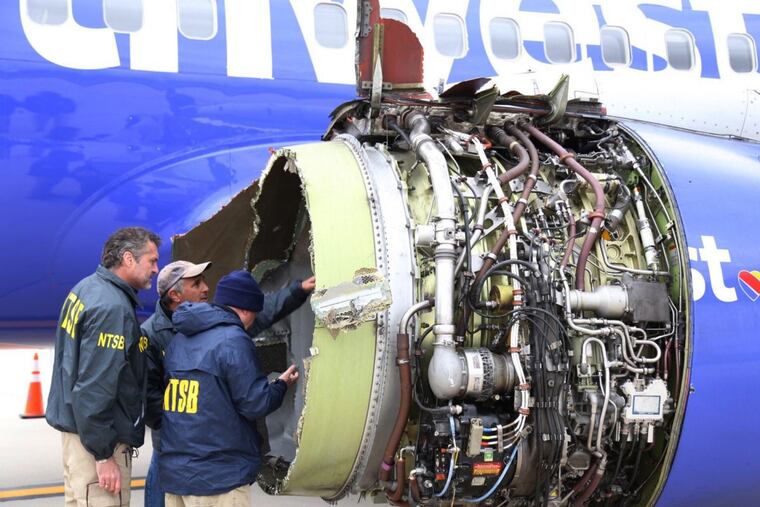Southwest wanted more time for inspections to spot engine flaws like the one that killed a woman Tuesday
Southwest told feds they needed more time to conduct inspections to spot flaws like the one that caused Monday's emergency plane landing.

Late last year, Southwest Airlines responded with a plea for more time to a proposed inspection protocol to identify flaws in fan blades like the one that caused one of its Boeing 737s to make an emergency landing in Philadelphia this week, documents show.
The proposal would be more sweeping than federal authorities anticipated, Southwest said in a letter to the Federal Aviation Administration. And it would need more time to implement the stricter inspections sought.
In August 2017 the FAA proposed for the first time an airworthiness directive to conduct ultrasonic inspections on fan blades, a test similar to an ultrasound that could identify cracks and flaws in the titanium plane parts that wouldn't be visible to the naked eye, on CFM56-7B engines. The FAA proposed the inspections after a fan blade broke on a plane in August 2016, causing damage to the fuselage and forcing an emergency landing in Pensacola, Fla.
On Tuesday morning, a fan blade broke in Southwest's Flight 1380 — a Boeing 737-700 equipped with CFM56-7B engines — from New York to Dallas. The break appears to have caused an engine failure that forced the plane to make an emergency landing at Philadelphia International Airport. The broken blade tore up the engine and threw debris against the plane, breaking a window. A New Mexico woman sustained fatal injuries when she was nearly blown out of the passenger cabin. The blades in both incidents showed evidence of fatigue cracks, weaknesses in the metal caused by stress.
Wednesday night, the FAA stated it would approve within the next two weeks a directive to inspect fan blades on all CFM56-7B engines with 15,000 cycles-in-service, about four years, without time spent in a maintenance shop.
In an October 2017 letter to the federal agency, Southwest reported it would not likely be able to get those tests done in the 12-month time period recommended by the FAA. The airline estimated that it would need 18 months to conduct the inspections.
The FAA anticipated that 220 engines in the United States would be affected by its order. In its October letter, Southwest reported 109 of its engines fell within the order's parameters. It added, though, that blades are swapped in and out of engines and aren't tracked. Because the company couldn't be sure how worn the individual blades were in each engine, the order would likely require the ultrasonic inspection on a total of 841 of its engines. Such a task would require more time.
By the time Southwest wrote that letter, the engine's manufacturer, CFM International, had already issued a bulletin, in June 2017, recommending the ultrasonic inspections for engines with 15,000 cycles. Airlines take those bulletins very seriously, experts have said.
Southwest has said the engine on the plane involved in Tuesday's incident would not have been subject to the parameters of the FAA directive. The company has not said whether the engine was subjected to the ultrasonic inspection or given details of its maintenance history. A review of FAA documents recording maintenance on the Boeing 737 involved in Tuesday's incident showed no prior engine problems.
Southwest, based in Dallas, did not reply to questions Thursday night about why its officials did not believe it could meet the 12-month deadline.
The incident remains under investigation by the National Transportation Safety Board. Officials have said they are focusing on studying the break area near where the blade connected to the turbine's hub to determine what caused the break, and what flaws may have existed in the metal.